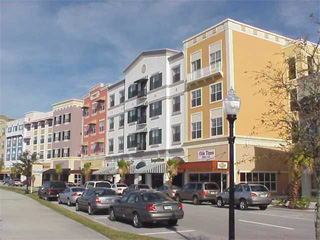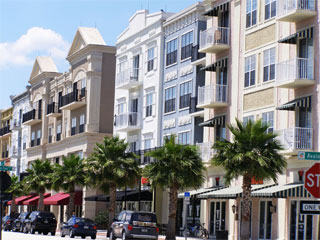|
|
Visualizing Orange County Density
What is Density? There are few words in the planning world that have so many meanings, both positive and negative, as the term density. Based on its most common definition, residential density is the number of housing units developed on an acre of land, expressed as a ratio (such as 4 units per acre). However, what seems like a simple number and ratio somehow ends up with a lot of "baggage." Those who don't like higher residential density may view increased density as the cause of increased crime and traffic, declining property values, and general disorder. Those who prefer increased residential density may view higher densities as the best and only housing choice, without recognizing the importance of lower densities and rural areas to the community. This Visualizing Density website avoids these debates and attempts only to illustrate what various residential density choices, ranging from urban to rural, may look like in Orange County. In doing so, it uses the range of residential density choices already in Orange County's communities, showing how feasible and compatible these different choices are and could be. What's Wrong with Density?The Lincoln Institute of Land Policy's Visualizing Density website defines the problem this way: "One reason people reject density is that they don't know much about it--what it looks like, how to build it, or whether it's something they can call home." Because density is largely expressed as a ratio of housing units to an acre of land, it can be difficult to visualize. Also, viewing density only as a number doesn't recognize the value of good community and building design in creating great places to live. Two neighborhoods with the same residential density may look very different, as shown by examples on the Lincoln Institute's Visualizing Density website. A community needs a range of densities to meet its needs, and no one density is better than another by definition. The different land use patterns throughout Orange County could accommodate a range of compatible and complementary densities, facilitated by great design. Orange County has diverse places, and this website is intended to show the County's emerging urban places, the vital and community-oriented suburban places, and the unique character of rural places, as well as the housing densities that may complement them. The Future of Density in Orange County In 2009, Orange County adopted an update to its Comprehensive Plan. This Plan sets policy for future community development, enhancement and preservation in the areas of land use, housing, transportation, conservation and other key topics. The goal of this new Comprehensive Plan is to accommodate growth within the County's existing urban area or areas planned to become urban to provide utilities and other public services more efficiently, help provide housing near transit, preserve and revitalize residential neighborhoods, and increase County residents' quality of life. To accomplish this goal, the housing developed in Orange County in coming years likely will be at a greater range of densities than seen in the past, and this guide will help residents, policymakers, business owners, and other community members envision what these changes may look like. While the Comprehensive Plan provides policy guidelines for an expanded range of densities, it is not the only reason we may start to see different densities in the future. Orange County residents increasingly are choosing new living options in developments of relatively higher densities than seen in the past, reflecting national trends. These trends are driven, in part, by retirement of the Baby Boom generation and the preferences of the Millennial generation, now in their 20s and forming their own households. Orange County has significant numbers of residents of both generations who likely will be seeking these housing choices. Orange County's cities have taken the lead in expanding the range of densities in recent housing developments, such as the City of Orlando's Baldwin Park and SoDo developments and the City of Maitland's Village at Lake Lilly. These developments, which can be viewed on this Visualizing Density website and others around Orange County, are being constructed in response to market demands for a wider range of housing choices in walkable, more urban settings. Currently Orange County has four residential density designations in the Urban Service Area, and others that allow residential development as part of a mixed-use development, as shown on its Future Land Use Map. Density is the total number of units divided by the developable land, less natural lakes and conservation areas. These residential densities are:
|
|